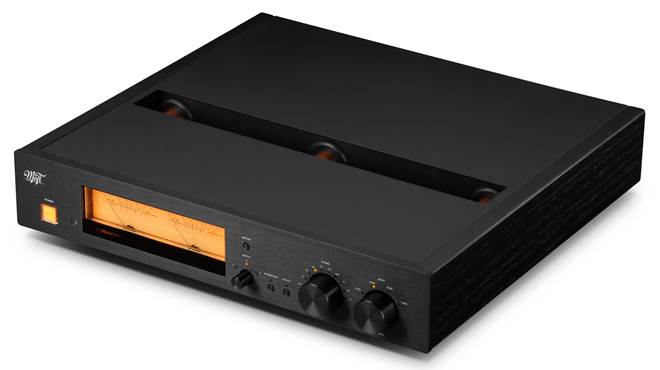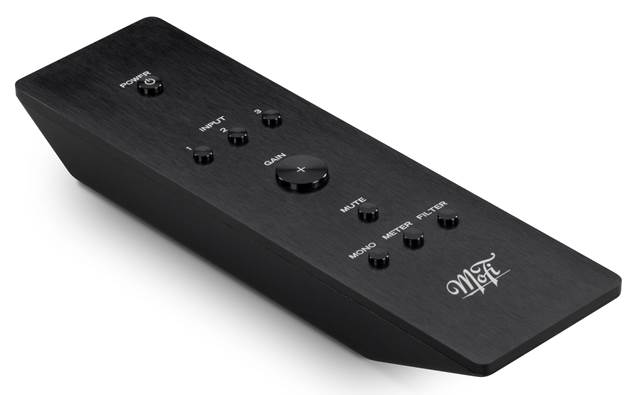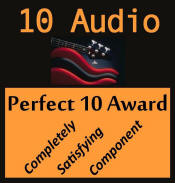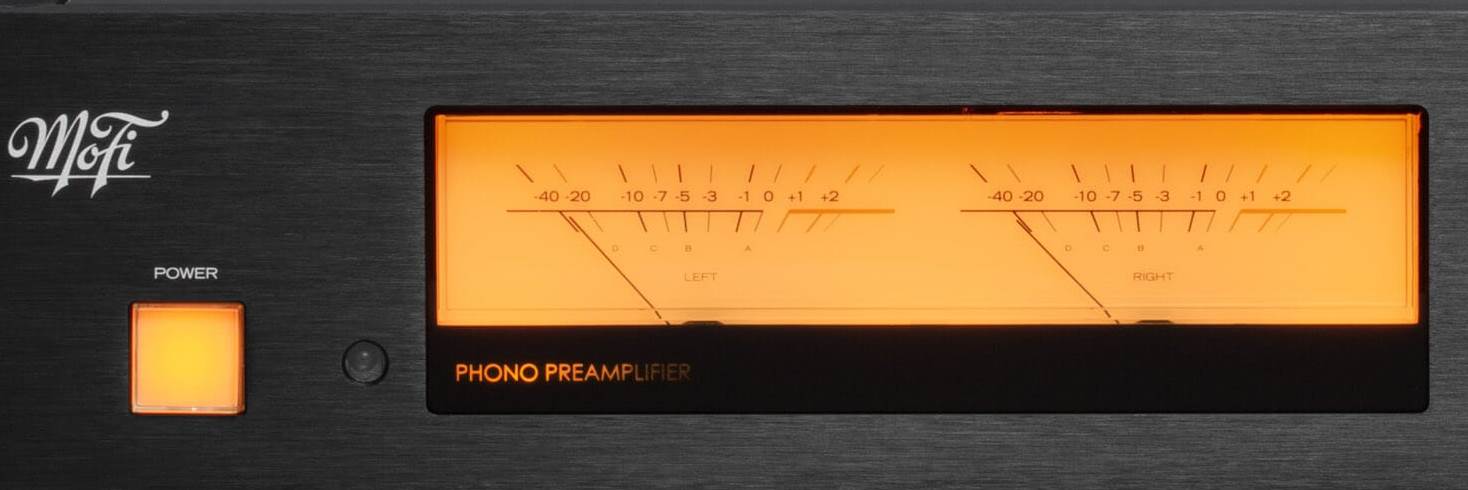The Mobile Fidelity Master Phono preamplifier has been available for a number of years with reviews available. This review is posted to give you another data point to factor in if you are considering acquiring this component. Executive summary: Consider it! Read on to grok that advice.

The Master Phono, $5,995, has a number of features that set it apart from almost all of the competition. Taken together, no other phono preamplifier offers all of these features. There are three inputs: one for the common voltage input on RCA and one input on balanced XLR, both for moving magnet and moving coil cartridges. There are four gain settings and nine impedance/load settings, plus one that you can use for your preferred value. The third input is a current input, which is most compatible with low impedance moving coil cartridges. For this input, the gain settings are in play, but the load settings are irrelevant because the load is essentially 0 Ohms, which is a short circuit. The current input has both a balanced connection on XLRs and an unbalanced input on RCAs.
There are two VU meters which can be used to precisely adjust the azimuth of your cartridge or just watch them dance while music is playing. The meters can be calibrated, using a test record, to show correct values for your cartridge. There is a subsonic filter and a mono button. The button labeled Meter turns off all lights on the front panel, power light included.
The chassis is physically divided and isolated to give the preamp what is effectively an “outboard” power supply. This undoubtedly benefits the sound with lower noise, the same way outboard power supplies affect most other gear.
The substantial metal remote control duplicates all the front panel settings. You can set gain and loading, in addition to mute, from the listening seat. This is a modern component offering the listener a full set of remote convenience and features.
To put this review in context, the review system includes an Acoustic Signature Montana Neo turntable with Acoustic Signature TA-7000 Neo and Origin Live Agile tonearms; a ZYX UNIverse Optimum, My Sonic Labs Signature Platinum, Miyajima Destiny, and Tzar DST moving coil phono cartridges, DS Audio Grand Master optical phono cartridge; CH Precision P1-X1 and EMM Labs DS EQ-1 phono preamplifiers. Digital components on hand during the audition include a custom Windows computer running JRiver Media Center with USB-connected Bricasti M1 Series II DAC, and RME ADI-2 Pro fs r Black Edition AD/DAC with After Dark external power supply. The system also includes Luxman C900u and Benchmark HPA4 preamplifiers; Constellation Inspiration 1.0 Stereo, Valvet E2 SE and Benchmark AHB2 power amplifiers; Alta Audio Celesta FRM-2M, B&W 805 D4, B&W 805 D4 Signature, and Magico S1 MkII speakers. The speakers are lightly augmented in the low bass, as needed, by a pair of JL Audio e110 subwoofers.
The audio cabling is Audioquest WEL Signature and Mogami interconnects and speaker cables. USB cables are Audience Front Row. Power cords include my DIY power cord and Straight Wire Pro Thunder. Headphones include Meze Elite and Hifiman Arya Stealth. Power protection and purification are provided by a PS Audio Dectet for the preamplifiers and source components, and a PS Audio Quintet for the power amplifiers. The Quintet includes a standard 1/8″ trigger connection enabling remote turn-on and -off of power amplifiers that lack a 12V remote trigger, which is a feature that every modern component should include. This does not include proprietary connections on RJ-45. Give us a break!

This is totally unfair, comparing a 15-pound $5,995 phono stage to the 95-pound $53,350 CH Precision P1 with X1 power supply combo. But that’s how we roll here at 10 Audio!
Using mostly the Tzar DST cartridge, with an output voltage of 0.25 mV and a DCR of 10 Ohms, the first set of observations were using one of the voltage inputs on the Master Phono (MP, for short). The loading was set to 1,000 Ohms following the recommendation of the US importer, Robyatt Audio. The gain was set for 50 dB, which is a good compromise between system-compatible gain and noise. Hum and noise were comparable to the P1, which has very low intrinsic hum and noise. Comparing the sound of these two phono preamplifiers, they are remarkably similar in overall disposition and tonal balance, where the P1 simply offers a little more very low-level resolution. The MP is just a bit less precise.
The fun really begins when we use the connections marked “Current Inputs”. Instantly noticeable is a marked increase in resolution and similarly identifiable decrease in internal noise. There is no hum and almost no hiss, although the latter increases with greater gain. The bass is more powerful and dynamic, and the overall sound seems faster and more upbeat. The upper frequencies are more immediate and have much cleaner initial or leading-edge impact. The sound is crisper with more air and treble extension. Cymbals have more bite, and all bells and percussion exhibit longer ring and fade-out. This is also consistent with gains in midrange warmth and presence.
Notably, the difference in sound quality between the voltage input and current input is greater than the difference between the sonics of the Master Phono and P1. (I’ll let that statement stand on its own and move on.)

We will focus on the sound using the current input for the remainder of this piece. The bass is not really “tight” in the usual sense, highlighting the more immediate sounds of each vibration of a string or tympani. There is a fullness to every sound in the lower octave that certainly includes what we usually term a “tight”, detailed and impactful sound. But this is accompanied, or filled out, or completed, with excellent resolution into the entire musical event. There is a wholeness to the sound that delivers the energy of the initial sound and importantly includes the entire note, harmonics and fade-out complete. There is an immediacy to every sound that seems to communicate the nuance and meaning, plus the power and drive, of the composition.
The midrange continues this sonic density with warmth and depth for all singers, both male and female. The sound is quite tube-like for the perception of realistic and welcome depth and texture in this critical range.
Departing from the usual practice of breaking down the sound into bass, midrange and treble, the Master Phono does something that is very rare IME for any audio component. This single, all-encompassing factor sets this unit apart and makes it nearly unique in the world of audio componentry, especially at anywhere close to the asking price.
The Master Phono offers the same quality of all sounds. There is no large or small frequency range that stands out as uniquely notable. The sound is not dull, bright, forward, recessed, or otherwise non-linear. A perfect component must offer sound that is tonally linear to avoid highlighting or recesses. The component must also, critically, deliver identical resolution at all audible frequencies so there is no added richness or thinness at any frequency. Linearity and resolution are the two factors that are required for any component to be considered a “reference”.
The Master Phono is incredibly well balanced and consistent sounding from low bass to upper treble. The sound is secure in the complete composure of all sounds, and all frequency-adjacent sounds. For example, the absence of increased “presence” in the upper midrange to lower treble that would otherwise increase the feeling of energy and liveliness. The lower midrange and upper bass are not especially noteworthy for added warmth, but what is present sounds very true to life. There is no added air or crispness in the mid-to-upper treble which can add an unnatural, but often pleasant, sense of space. Without these aberrations, the Master Phono delivers Truth. The soundstage is large: wide, deep, and tall with excellent precision in the placement of musicians and instruments.

The Master Phono, along with a few digital recordings, helped to identify the shortcomings in the previous amplifier review, and helped to understand the more nuanced differences between the established B&W 805 D4 and the newer 805 D4 Signature speakers. This extreme, seemingly perfect, neutrality can help to quickly identify non-linearities, or “character”, coming from other system components.
Even though the current inputs on phono preamplifiers usually suggest low-impedance phono cartridges, the MP worked very well with the 10 Ohm DCR (DC resistance) Tzar DST as well as the 1 Ohm ZYX UNIverse Optimum. The 1.4 Ohm My Sonic Labs Signature Platinum was also a great a match for the current input. The 16 Ohm Miyajima destiny seemed a little uncomfortable with this input but sounded great into the voltage input. The advantages of the current input are significant enough to warrant replacing your phono cartridge if a good match is not quickly obvious. Even so, I recommend an initial audition of at least a week so your brain can appreciate what the MP is putting in your ears and not simply any differences to what you are used to hearing. The absence of a problem takes longer to identify than its presence.
This is one of the two best conventional phono preamplifiers this lifelong audiophile has heard due to its seemingly perfect tonal linearity and consistent resolution all across the musical spectrum. For another $47,000 or so, you might enjoy incremental sonic improvements, but the Master Phono doesn’t disappoint with its excellent resolution and very enjoyable – very consistent – sound. One can build a reference level system around the Mobile Fidelity Master Phono, where all components share an intrinsic neutrality and are capable of very high listener satisfaction.
Overall Rating: 10 LPs

Link to manufacturer: MoFi Electronics
Manufacturer’s Comment:
MoFi Electronics began nearly a decade ago. We reached out to some of the best designers and engineers we could find—the kind of people who know what makes sound come alive—and we asked them to help us build the things we’d been wishing for all along. That’s how the MasterPhono came to be, the best parts of all our ideas woven together, then taken to another level by Peter Madnick’s steady hand and knack for engineering.
One of the things I wanted more than anything was to be able to set the load for MC cartridges without breaking a sweat. I’ve had my share of phono preamps, the kinds that require you to wrestle with dip switches or, worse yet, crack open the top panel just to make a change. MasterPhono lets me swap cartridges easily.
And then there’s the current-source input, a curious and brilliant addition. As the My Sonic Lab importer, we’ve come to know the peculiar magic of low-impedance cartridges and how they almost seem to bloom with a current-source input. Peter had to bolster the power supply to make it sing, and it didn’t just support the current source; it gave the voltage inputs a new strength too. There’s something in that setup that feels like a mystery, the way it makes the sound open up, surround you, like you could close your eyes and lose yourself in the music hanging in the air.
Thank you for the brilliant review.
All the best,
Jonathan Derda
VP of Sales & Marketing

